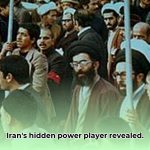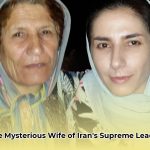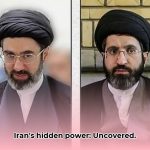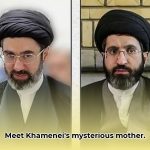Who is Mansoureh Khojasteh Bagherzadeh? The wife of Iran’s Supreme Leader, Ali Khamenei remains an enigmatic figure, shrouded in secrecy. Surprisingly little is definitively known about her life. This article endeavors to assemble the known facts about her – her family history, her marriage, and her ambiguous role in Iranian politics. The inherent secrecy surrounding her and the Iranian government presents considerable challenges to uncovering the full story. We aim to explore verifiable information, highlighting where data is scarce or absent, and consider how future research could illuminate her life and impact. For a more detailed biography, see her biography here.
Marriage of Ali Khamenei and Mansoureh: A Life Largely Unknown
The 1964 marriage of Ali Khamenei and Mansoureh Khojasteh Bagherzadeh presents a fascinating, yet frustrating, puzzle for historians and researchers. Despite knowing they wed, verified details of Mansoureh’s life remain scarce. This information deficit obstructs a comprehensive understanding of her influence on Khamenei, her personal beliefs, and her contributions to Iranian society. Let’s investigate the limited information available and, more importantly, what crucial aspects remain unknown.
Mansoureh’s Early Life: Unveiling Family History
Mansoureh Khojasteh Bagherzadeh was born in 1947 in Mashhad, Iran, into a family deeply rooted in religious tradition and commerce. Her father, Mohammad Esmaeil Khojasteh Bagherzadeh, was a well-known businessman in Mashhad, suggesting a comfortable upbringing within the Iranian elite. Her brother, Hassan Khojasteh Bagherzadeh, later served as the deputy director of IRIB (Islamic Republic of Iran Broadcasting), further illustrating the family’s connections within Iranian society.
Ali Khamenei, born in 1939, also hailed from a religious family, though of more modest means. His father was an Alim, a religious scholar. The Khamenei family home, reportedly only 65 square meters, was located in a poorer neighborhood.
The marriage between Ali Khamenei and Mansoureh Khojasteh Bagherzadeh took place in 1964 or 1965. The marriage sermon was conducted by Ayatollah Mohammad Hadi Milani. At the time of their marriage, Mansoureh was about 17 or 18 years old, while Ali Khamenei was around 25.
Did Mansoureh’s affluent, religious background in Mashhad influence their relationship, or was it merely a convergence of separate paths? Insufficient data prevents definitive conclusions. Post-marriage, Mansoureh largely disappeared from public view. Although she seemingly supported Khamenei’s revolutionary activities, her perspectives are notably absent from historical records. This silence, a notable facet of her story, speaks volumes.
Revolution and its Impact: Shaping a Private Life
The Iranian Revolution profoundly altered Khamenei’s trajectory, elevating him to supreme power. Inevitably, Mansoureh’s life intertwined with his. While she likely provided support during volatile times, the specifics of her contributions remain speculative. Did she offer political counsel, manage household affairs, enabling him to focus on his career? These questions, like others, remain unanswered.
Information Access: The Veil of Secrecy
Researching Mansoureh’s life presents notable obstacles. Iran’s political system tightly controls information, hindering access to personal records and reliable accounts. Many sources offer opinions, but concrete evidence remains sparse. This opacity reflects broader restrictions on women’s roles within the Iranian establishment, even those associated with powerful leaders. This lack of transparency fuels her mystique.
Known Facts: Separating Truth from Speculation
Mansoureh supported her husband throughout his career. Images show a reserved woman beside her politically prominent spouse. However, her political involvement, personal beliefs, and independent contributions remain largely unknown. Information is lacking regarding her education, professional life, or personal financial situation.
Many theories exist; however, solid conclusions remain elusive. Did she participate in political discussions, exert a quiet influence, or actively shape decisions? Current evidence is inadequate.
Further Research: Pathways to Discovery
Unlocking Mansoureh’s secrets necessitates a multifaceted approach to address the missing pieces:
- Oral Histories: Interviewing those who knew her could provide valuable insights into her personality, though political sensitivities exist.
- Archival Research: Iranian archives, if accessible, might contain letters or official records.
- Comparative Studies: Comparing her life to other prominent Iranian women could provide beneficial context.
Mansoureh’s Legacy: An Enduring Enigma
Ali Khamenei and Mansoureh’s marriage highlights the research obstacles in understanding powerful figures’ private lives in closed societies. Mansoureh’s lack of a readily available story is a narrative in itself, highlighting the limits of public knowledge and the tension between power, privacy, and public knowledge. Future research may reveal new understandings.
The couple has six children: Mostafa, Mojtaba, Masoud, Meysam, Boshra, and Hoda. These children, through their own marriages and careers, have further extended the Khamenei family’s influence within Iranian society.
How Did Mansoureh Khojasteh Bagherzadeh Influence Iranian Politics?
Mansoureh Khojasteh Bagherzadeh, the wife of Iran’s Supreme Leader Ali Khamenei, operates largely in the shadows. Her secretive life provides a glimpse into the inner circles of Iranian power. But how did Mansoureh Khojasteh Bagherzadeh influence Iranian politics? The answer is complex and mostly unknown.
A Secretive Life: Unveiling the Unknown
Even fundamental biographical details are sometimes contested, including her exact birthdate and birthplace. This uncertainty reflects the tight control of information surrounding the Khamenei family. Her relatives, however, are undeniably well-connected. Her father was a successful Mashhad businessman, and her brother was at IRIB, suggestive of a life interwoven with Iran’s elite, making one wonder what role she played in the country’s political landscape directly or indirectly.
The Power of Proximity: Assessing Hidden Influence
While absent from a formal political role, her influence is likely derived from her marriage to the Supreme Leader. Consider her access and influence unavailable to most. Conversations and informal advice could indirectly shape policy. Her family’s extensive network amplifies this influence, with powerful sons-in-law creating connections throughout political and religious circles.
Her sons have also become influential figures in Iranian society. Mojtaba Khamenei, in particular, has been a subject of speculation, with some considering him a potential successor to his father. While Mansoureh’s direct involvement in her sons’ political activities remains unclear, her role as their mother undoubtedly carries weight.
Limits of Access: Navigating Iranian Politics
Difficulty researching this topic must be acknowledged. Iran’s political climate limits access to information on prominent figures, particularly those close to leadership. This lack of transparency hinders access to primary sources and thorough investigations, leaving much of what is known speculative.
Family: A Legacy of Influence
The Khamenei family’s well-documented network suggests that Mansoureh’s contribution extends beyond being the Supreme Leader’s spouse. Embedded in Iran’s power structure, her family ties provided a mechanism for influence far beyond her personal life, essential to comprehending how did Mansoureh Khojasteh Bagherzadeh influence Iranian politics.
Unveiling the Enigma: Paths to Discovery
Future research requires a multifaceted approach to improve understanding including:
- Accessing Iranian archives: Limited access requires persistent efforts.
- Comparative analysis: Comparing the lives of spouses of other world leaders can provide a framework.
- Ethical interviews: Challenging ethical interviews with knowledgeable individuals could offer valuable accounts.
Transparency remains key. This case highlights the importance of rigorous research in uncovering the hidden dynamics of power.
Key Takeaways:
- Mansoureh Khojasteh Bagherzadeh’s life, shrouded in secrecy, complicates assessing her direct political influence.
- Her marriage to Supreme Leader Ali Khamenei and her family’s network suggests indirect influence.
- Limited information access hinders comprehensive research.
- Future research should explore archival materials and ethical interviews where possible.
- The intricate family connections within Iran’s power structure are critical to understanding influence.
Mansoureh Khojasteh’s Role in Khamenei’s Early Political Campaigns
Key Takeaways:
- Mansoureh Khojasteh Bagherzadeh, wife of Supreme Leader Ali Khamenei, is a figure whose life remains largely private, shrouded in secrecy.
- Information regarding her background, beliefs, and involvement in Khamenei’s early campaigns is scarce.
- Understanding her potential influence requires analyzing Iran’s socio-political context and the roles women play traditionally.
- While her direct participation is unconfirmed, her position as a spouse likely influenced Khamenei’s life and decisions indirectly.
- Future research needs to leverage archival materials and ethically sound interviews.
A Life Behind the Veil: The Khamenei Enigma
What do we truly know about Mansoureh Khojasteh Bagherzadeh? As the wife of Iran’s Supreme Leader, Ali Khamenei, she exists in the shadows. Her life is a puzzle because of its elusive nature. We know she married Khamenei around 1964, with a birth year estimated around 1947. Beyond these facts, solid evidence is remarkably thin, which illustrates challenges researching powerful figures, particularly in Iran.
Did the Campaigns Shape
- Unveiling the Enigma: Mansoureh Khojasteh Bagherzadeh’s Personal History: A Comprehensive Biography - July 18, 2025
- Rare Mansoureh Khojasteh Bagherzadeh Interviews: Unveiling Iran’s Power Dynamics - July 18, 2025
- Unveiling the Enigma: Ali Khamenei and Mansoureh’s Marriage — A Deep Dive - July 18, 2025














